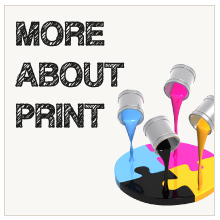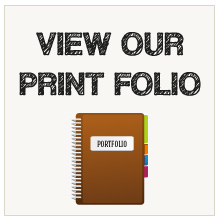DIFFERENCES BETWEEN OFFSET AND DIGITAL PRINTING
We often get asked, “Which is better – offset or digital printing?” and our answer is always, “It depends.” While both are popular forms of commercial printing, they have significant differences that make one more preferable over the other for each print job. So how exactly do offset and digital printing work?
Offset printing
– Sometimes called offset lithography require large presses that use plates and ink. Once design is ready for output, the image is made into film negatives. From the film, the image is made into metal printing plates. Each primary print colour (cyan, magenta, yellow and black) has a separate printing plate. On the press, water dampens the printing plate and ink rolled on. The ink adheres to the image area, while the water to the non-image area. The image is then transferred to a rubber blanket. And finally the rubber blanket will roll the ink and build layers of colours onto the paper.Digital printing
– The simplest form of digital printing are the documents that you print using the desktop printers at home or office. Digital content is rendered through a software program so that it will be ready for printing. The image is then digitally transferred to paper using electrical charges and dry/liquid toner. Digital printing eliminates many of the steps of traditional offset printing, as you can print straight away from your computer with a click of a button.| OFFSET | vs | DIGITAL |
|---|---|---|
| Most cost-effective for high volume. |  |
Most cost-effective for short runs. |
| Minimum 500 pcs. |  |
Minimum 1 pc. |
| Rich and vivid colours. Exact PMS tones and consistent solid colours can be achieved. |  |
Can't match the colour quality of offset printing but able to produce vibrant CMYK colours. |
| 3-7 days or more. (depends on complexity of job) |  |
Almost immediate. |
| Wide range available and allows heavier stock. |  |
Limited range and only up to 350gsm stock. |
| Not easily available and will be expensive. Best option is to print template that can later be personalized with laser/inkjet printers. |  |
Variable data printing and on-demand printing available for customized marketing materials. |
| Business Cards, Letterheads Brochures, Calendars, Catalogues, Annual Reports, Paper Bags, Boxes, Magazines, Books and more. |  |
Business Cards, Certificates, Direct Mailers, Flyers, Wedding Invites, Restaurant Menus, Posters, and more. |
| More choices of recycled paper available and choice to use soy or vegetable-based inks. |  |
Less waste produced. |
Now that you know the differences, it all comes down to the needs and requirements of your project. Digital is clearly the best option for small quantities and quick delivery, while if you have quite a number to print and you have a little more time to spare, traditional offset printing is the way to go. Still, if you are not sure, you don't need to figure it out all alone. You are always welcome to contact us and we will be more than happy to find the best solution for your print project.




